How to plant and grow grapes on the balcony
Residents of city apartments often lack the greenery and beauty of living plants. To enjoy the harmony of nature, you don’t have to go outside the city. How to do it? Using a tub system for growing grapes that will cover the entire space on the balcony.
Grapes are an unpretentious plant; many of its varieties are cold-resistant and undemanding to care. In a pot on the balcony it is possible to grow wild “girlish” grapes or a crop that produces tasty and juicy fruits. However, caring for a vine at home differs from growing it in open ground.
Is it possible to grow grapes on a balcony and what varieties are suitable for this?
Grapes can be grown on the balcony. The plant does not require a large area - a pot or box is enough - and at the same time grows long vines.
More often decorative grapes are grown on the balcony, which are called maiden grapes. It is the most unpretentious to care for, is able to grow in shaded areas and is characterized by rapid development. The main feature of this vine is its red leaves, shaped like ivy. The fruits of the plant are small and tasteless; they are not used for food.
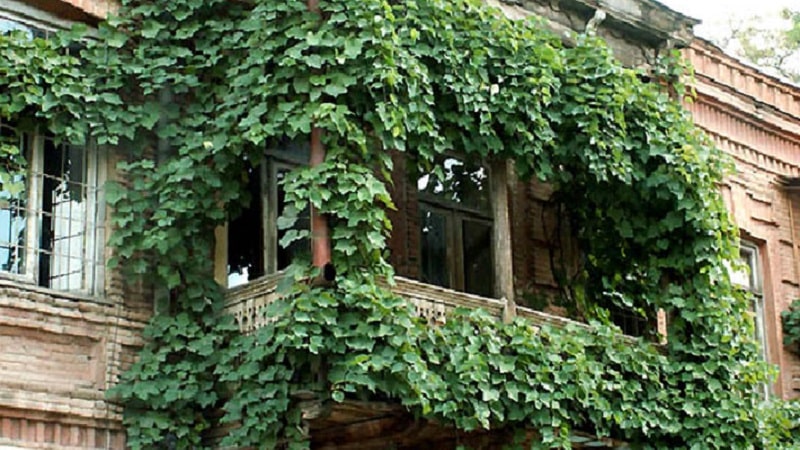
Cultivated grapes are also cultivated on the balcony. It looks less aesthetically pleasing, but is also capable of completely weaving a balcony. Its main advantage is its delicious edible fruits, which are harvested in summer and early autumn.
Not all cultivated varieties are suitable for the balcony: female varieties are not suitable, as they require artificial pollination. It is worth planting bisexual varieties that are considered self-pollinating:
- Laura;
- Delight;
- Russian Concorde;
- Victoria.
When choosing a variety, pay attention to cold resistance. Heat-loving grapes are not suitable for the middle zone.
Planting grapes
Growing grapes on a balcony in a box is not a difficult task. To prevent the plant from dying and developing properly, it is important to pay attention to the planting process. This stage is no less important than subsequent care of the vine.
Preparing the balcony
Usually a balcony is chosen for growing, since it is in this part of the apartment that it is easiest to create the necessary conditions and demonstrate to your neighbors the beauty of the climbing plant.
Grapes are a light-loving crop. Balconies that are located on the south, southwest or southeast side are most suitable for it. Lianas planted in the northern part of the house will require additional lighting. An exception is wild grapes, which feel good even in the shade.
This is interesting! Red (brown) leaves indicate that the plant easily tolerates a lack of sunlight.
To provide better lighting, the walls on the balcony are sheathed with reflective material (foil). The larger the window on the balcony, the better the plant feels.
To prevent the grapes from freezing in winter, the balcony is insulated. The insulation is placed under reflective material.

Selecting a container and preparing the soil
The soil for planting should be loose and nutritious. A universal primer, which is sold in the store, is suitable. However, a lot of land is required, so most gardeners prefer to prepare the soil themselves. To do this, mix:
- garden soil (preferably chernozem) – 5 parts;
- humus or rotted manure - 3 parts;
- clean river sand – 2 parts.
All ingredients are mixed. Add 30 g of urea, 25 g of superphosphate and 20 g of potassium salts for every 10 kg to both purchased and homemade soil mixtures.
The soil is disinfected using one of the methods:
- calcined in the oven;
- pour over with a dark pink solution of potassium permanganate;
- water with a solution prepared from 1 tbsp. l. copper sulfate and a bucket of water.
No less attention is paid to the choice of containers. First, the plants are planted in ordinary flower pots or boxes. As the grapes grow, the size of the containers increases. The container volume for adult grapes is from 60 to 350 liters. The larger the pot, the stronger the grapes will grow.
There should be drainage holes at the bottom of the containers. They will prevent fluid stagnation, which causes many diseases. To disinfect grape pots, they are soaked in a dark pink solution of potassium permanganate or poured with boiling water.
Important! When planting grapes, drainage is used: shell rock, small crushed stone, expanded clay, broken ceramics or brick, and special glass balls.
Methods of growing grapes
Grapes are grown by generative and vegetative methods. In the first case, seeds collected from fruits are used. This method is the longest and allows you to grow only wild plants.
Before sowing the seeds, they are soaked in salted water.. Specimens that have sunk to the bottom are suitable for sowing, while those that have floated up are dummies. Then the seeds are disinfected in a light pink solution of potassium permanganate and soaked for 6-12 hours in a growth stimulator (“Solution”).
Prepared seeds are sown in the ground, covered with film and wait for seedlings to appear., regularly watering and airing.When 2 true leaves appear on the seedlings, the plants are planted in individual pots. Then they are transplanted into larger containers as they grow, and after a year they are placed on the balcony.
Interesting things on the site:
The vegetative propagation method is much more often used.. It is suitable for any variety and allows you to quickly obtain an adult fruit-bearing plant.
When propagating by layering, a one-year-old grape vine is pressed to the soil and covered with soil. at the base. It is watered and fed all summer, and in the fall it is cut off from the mother plant along with the formed roots. Until next spring, the grapes are kept in a pot at home, and then transplanted to a permanent place.
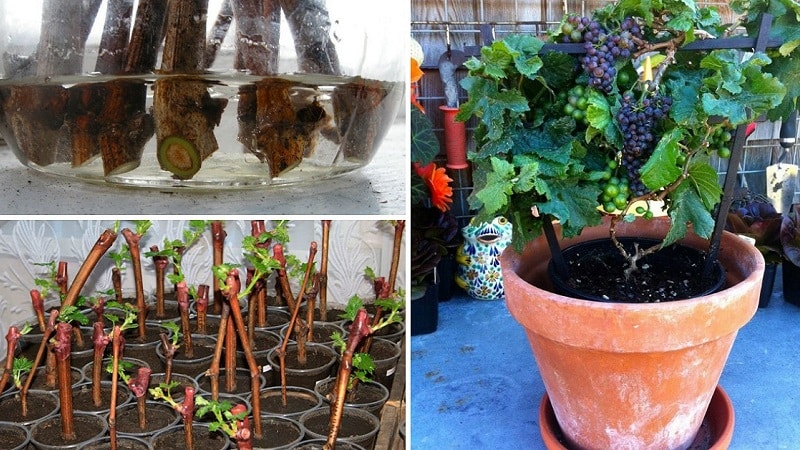
The most common method is propagation by cuttings, which are obtained during the formation of grapes. The main thing is that 2-3 buds remain on the grape pruning.
Place the cuttings in a glass of water and wait for the roots to appear.. This takes 2-3 weeks. It is then transplanted into a small pot for rooting. One-year-old plants are planted on the balcony.
Note! The easiest way to grow grapes on the balcony is to buy a ready-made seedling. It must have a developed, not dry root system, a hard but elastic bark and developed buds.
Step-by-step instructions for planting grapes
A seedling purchased or grown independently is planted in late February or early March.. If the planting material is of high quality and the planting procedure was carried out correctly, it will quickly take root and begin to sprout.
Procedure:
- The seedling is disinfected: roots for 30-60 minutes. dipped in a light pink solution of potassium permanganate.
- To help planting material take root, a growth stimulator (Kornevin) is used.
- Place 1 cm of drainage at the bottom of a pot with a volume of at least 3 liters. The rest of the space is covered with soil. The soil is watered with warm, settled water.
- The plant is planted so that the bottom leaf does not touch the soil. The soil around is compacted and watered again with warm water.
- Until the seedling takes root, it is kept under a dark film, which is removed daily for 15-30 minutes. for ventilation. As the soil dries, the soil is moistened and the vine is sprayed with a spray bottle.
- When shoots begin to form, the duration of ventilation is increased. After a week, the film is removed.
Grapes are brought to the balcony no earlier than the second half of April or early May. The plant is gradually accustomed to new conditions: first it is taken out for half an hour, then the time is gradually increased to a day. Only after this is the pot with the vine finally moved to the balcony.
Rules for caring for grapes on the balcony
Caring for grapes does not take much time; even a novice gardener can handle it.
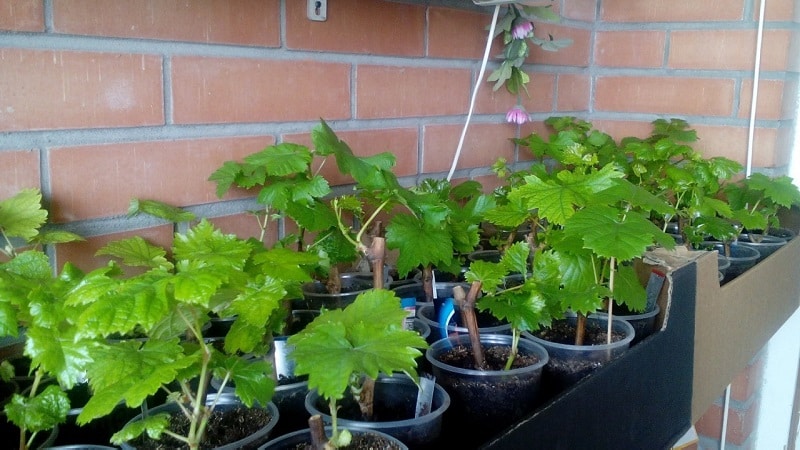
Watering
The grapes are watered 1-2 times a week. The hotter it is outside, the more often the soil is moistened. For irrigation use water at room temperature. Cold liquid is one of the main reasons for the development of fungal infections, including root rot.
Water the grapes early in the morning or late in the evening when the sun is inactive. Otherwise, the plant will get burned. During the fruiting period, the amount of watering is reduced, just to prevent the soil from drying out.
Loosening
A day after watering, the soil is loosened to destroy the earthen crust., preventing air exchange.
Spraying
If the summer turns out to be dry, the leaves are sprayed three times per season.. For this procedure, warm, settled water is used. Spraying is carried out when the sun is inactive.
Transshipments
During the first 2-3 years, the grapes are repeatedly transferred to a new pot., as soon as the root system fills the previous one. The plant is removed from the pot without destroying the earthen ball. Using a dull knife, remove the drainage and the top layer 2-3 cm thick. The root system is inspected and all damaged shoots are removed.
A layer of disinfected drainage is poured into a new pot, which is larger in volume than the previous one, then the vine is placed along with a lump of earth, the free space is filled with new fertile soil. The grapes are watered abundantly and placed in a shaded place for a week.
Transplants
After the first fruiting, transshipment is stopped, but the plant is replanted once every 2-3 years.. The grapes are removed from the pot and a third of the earthen coma is removed. The roots and crown are also cut by a third, and rotten and dry shoots are removed.
Drainage and a layer of sand are poured into the new pot. The plant is installed without deepening the root collar. The free space in the container is filled with earth. After this, the grapes are watered and put in a dark place for a week. Before the first transplant, unformed fruits are completely torn off.
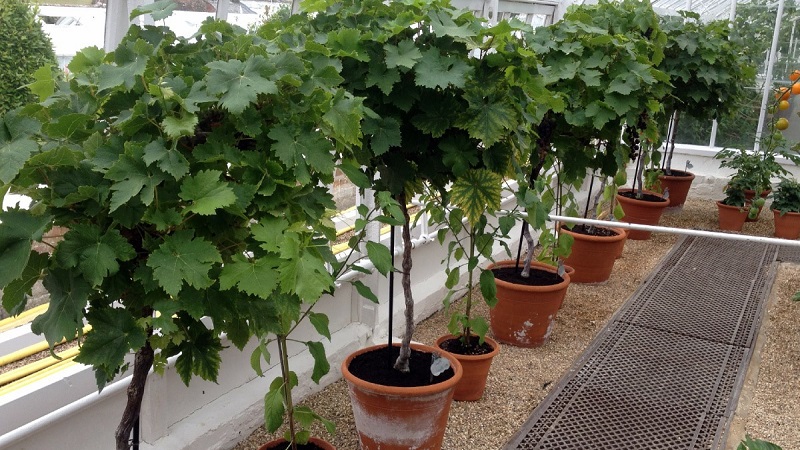
Feeding
Grapes grown on the balcony need additional feeding. Fertilizers are applied only to pre-watered soil according to the following scheme:
- At the beginning of March - the first fertilizing with a high content of nitrogen, necessary for the growth of green mass. The composition should include a complex of microelements.
- The second and third time fertilizers are applied in the summer with a break of a month. A mixture of nitrogen, phosphorus, potassium and microelements is added to the soil. Such products will strengthen the ovaries and young shoots.
- When the berries reach their maximum size, the grapes are fed a fourth time. The fertilizer should contain large amounts of phosphorus and potassium. It is not recommended to use nitrogen, otherwise the plant will spend energy not on ripening the berries, but on growing green mass.
- When the berries begin to ripen, do not feed at the root. Instead, the grapes are sprayed with a mixture of microelements that accelerate the ripening of the berries.
- After harvesting, fertilizers are applied for the last time for the season. These should include phosphorus, magnesium and potassium. They should not contain nitrogen.
Shaping and trimming
Grapes on the balcony form the same as in open ground. The procedure is carried out in the fall.
Every year, the most powerful and healthy ones are selected from new vines. They are divided into pairs. In each pair, one vine is cut by two-thirds, and 2-3 buds are left on the other.
The long vine will produce vines next year on which the harvest will form. The short vine will produce powerful shoots.
After the long vine produces a crop, it is cut down to the base.. Shoots grown from short vines are formed according to the described principle.
Sanitary pruning is carried out annually – removal of old and diseased branches.
How to make grapes entwine a balcony? For this he will need support. If the building has a lattice or columns, the vines are allowed to climb along them. If there are none, attach ropes to the outside of the windows and use them as supports.
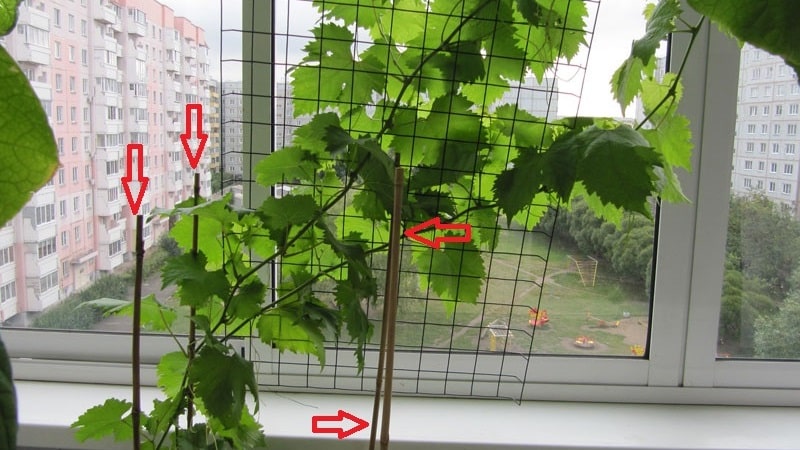
Preparing for winter
Grapes are left to overwinter on the balcony only if the temperature there does not drop below 0°C. In this case, the vines are removed from the supports and laid on the floor. They are covered with burlap on top and covered with peat or sawdust.
In spring the mulch is removed. The vines are being sent back up the supports.
If it’s cold on the balcony, the plant is brought into the apartment. At temperatures up to +10°C, the grapes will be at rest. If a cool place is not found, the plant’s vines are attached to a support installed at home.
The liana is watered and fed as in summer, and additional lighting is provided. Under such conditions, grapes often produce a second harvest.
Read also:
Conclusion
The grapes will become a real decoration for the balcony. It will allow the owner of a city apartment to mentally move to a cozy gazebo in a country house. Windows braided with its vines will look attractive both from the street and inside the house.
Growing grapes on a balcony is no more difficult than in open ground. If you follow the basic rules of care, the plant will not cause problems and will delight you with annual harvests.